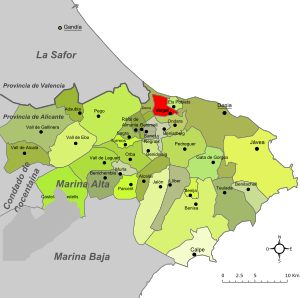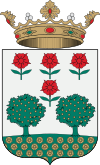El Verger facts for kids
Quick facts for kids
El Verger
|
||
|---|---|---|
|
||
 |
||
| Country | ||
| Autonomous community | ||
| Province | Alicante | |
| Comarca | Marina Alta | |
| Judicial district | Dénia | |
| Area | ||
| • Total | 8.16 km2 (3.15 sq mi) | |
| Elevation | 25 m (82 ft) | |
| Population
(2018)
|
||
| • Total | 4,520 | |
| • Density | 553.9/km2 (1,434.7/sq mi) | |
| Demonym(s) | Vergerí, vergerina Vergerer, vergerera |
|
| Time zone | UTC+1 (CET) | |
| • Summer (DST) | UTC+2 (CEST) | |
| Postal code |
03770
|
|
| Official language(s) | Valencian | |
El Verger is a small town in Spain with about 4,992 people. It's located very close to the Mediterranean Sea, only 3 kilometers away. Another larger town, Dénia, is 8 kilometers from El Verger. The town is part of the Marina Alta region in the Valencian Community.
Some of the cool things to see in El Verger include its Main Street, two old medieval towers, and a beautiful church built in a style called neoclassical. The town's symbol, or crest, shows two trees and four flowers. This design honors the town's name, which means "orchard" or "garden." Did you know that the Prime Meridian, an imaginary line that divides the Earth, actually passes through El Verger?
Contents
Exploring El Verger's Geography
El Verger is surrounded by other towns like Beniarbeig, Benimeli, and Dénia. It's about 91 kilometers from both Alicante and Valencia. The town is also on the border between the provinces of Alicante and Valencia.
The Mediterranean Sea is just 3 kilometers to the northeast. A river called the river Girona flows through the town, splitting it into two parts. Most of El Verger is on the western side of the river. Three bridges help people cross to the other side and reach the sea.
Behind El Verger, you'll find the Segària mountain range. This area is very popular for hiking and exploring nature. In fact, the local school is named after this mountain! A lot of the land around El Verger is used for agriculture. Farmers grow many vegetables and citrus fruits here, like oranges and lemons.
A Look Back at El Verger's History
El Verger was once a collection of houses and lands owned by a wealthy Arab person from Dénia. In 1245, King Jaume I's army took control of the area. It was then given to Pedro Eiximén Carròs, one of the king's captains. At that time, most of the people living there were Muslim.
The town was part of the taifa (a Muslim kingdom) of Dénia. After the Christian reconquest, it became part of the Marquesat de Dénia. Later, it joined the historical region of Marina.
In 1609, many people of Muslim background, called Moriscos, were forced to leave Spain. This left El Verger almost empty. Like many places in the País Valencià (Valencian Country), new people came to live here. Many of them came from the Illes Balears (Balearic Islands), especially Mallorca. This is why you might hear some words and ways of speaking in El Verger that are similar to those in Mallorca.
On October 12, 2007, there was a very heavy rainstorm. More than 400 millimeters of rain fell, causing the Girona river to overflow. This flood damaged 80 houses along the river in El Verger. In some streets, the water reached two meters high! It was the biggest flood ever recorded for the Girona river. Bridges were damaged, and sadly, one person lost their life.
Who Lives in El Verger?
Today, El Verger has about 4,839 people living there. About 18.40% of the residents are from outside Spain. Many of these people come from Morocco, Germany, and Romania.
Culture and Fun in El Verger
The town's public library is in the old train station, right behind the town hall. It has many books and magazines in both Valencian and Spanish. You can also use the internet for free there.
The most important cultural spot is La Fàbrica de Sabó, which means "The Soap Factory." This used to be an industrial warehouse but has been turned into a cultural center. El Verger also has several music groups. One group, known for playing the dolçaina (a traditional wind instrument), is very famous!
The main language spoken in El Verger is Valencian. According to a 1991 survey, almost everyone (97.9%) can understand it. About 87.8% can speak it, and 63.2% can read it. About 30.4% of people can write in Valencian.
Exciting Festivals in El Verger
El Verger is well-known for its lively festivals! One of the most famous is the Moros i Cristians (Moors and Christians) festival, held from August 12th to 15th. This festival celebrates the history of Spain with parades and costumes.
Another popular event is the Nit de les Paelles (Paella Night). During this night, groups of friends set up camp in the street and cook huge amounts of paella, a famous Spanish rice dish. There's also Bous al Carrer, which means "Bulls in the Street." This involves running with cows (not bulls) in the main street.
Other celebrations include festivals for the town's patron saints: Our Lady of the Rosary, Saint Roch, and Saint Isidore. There are also Carrosses (parades with decorated floats), a medieval market, and a trade fair. Near the river, there's a picnic area with special spots for cooking paella.
Places of Worship
El Verger has one church, which is located next to the Torre del Palau in the southern part of town. The patron saint of El Verger is Saint Roch. The patroness is the Virgin of the Rosary.
How El Verger is Governed
The town hall is located where an old school used to be. It has a special entrance with a bridge that crosses over a fountain. The current mayor, called an Alcalde in Spanish, is Ximo Coll. He belongs to the PSOE political party.
Shops and Services in Town
El Verger has many different shops and services. You'll find bars and cafes, clothing stores, and shops selling everyday items. There's also a stationery shop and stores for building materials. The town has two supermarkets: Mas y Mas and Aldi. In the commercial area north of town, there are many warehouses selling materials and household goods.
Other important services include a pharmacy, the post office, the library, and a tourist information office. There's also a center for homemakers. Every Friday, a market is held in the town.
Getting Around El Verger
The Alsa bus company provides public transport. You can take buses from El Verger to Valencia, Alicante, and Dénia. The old train station in town reminds us that a railway used to pass through El Verger. Today, the closest train stations are in Gandia and Dénia.
Major roads like the N332 and the A7 highway connect El Verger to the wider road network.
Interesting Places to Visit
- Church of the Virgin of the Rosary: This church is built in a neoclassical style and was finished in 1732. It replaced an older, smaller church. Inside, you can see a statue of the Virgin of the Rosary, who is the town's patroness. Most of the church's art and decorations are from after 1936, except for a statue of Saint Stephen. This statue was saved from a fire by a family who hid it in their home.
- Blanc de Morell Tower or Cremadella Tower: This is an old tower from the Middle Ages, with parts dating back to the 11th and 12th centuries. It has an interesting Arab origin and is located in the countryside area called Cremadella.
- Palace of Medinaceli Tower: This tower houses the tourist office and is located on Church Street.
- Old Arab Wall: You can still see some parts of an old Arab wall. These parts are now built into the wall that holds back the Girona river.
- Old Town Hall: This building is on the old highway street.
- Main Street: This is the most famous street in El Verger. It has many colorful houses built in a traditional style.
- Segària Mountain: This mountain is a popular spot for hiking. It's shared with the nearby towns of Ondara and Beniarbeig.
- Safari Park: Located just north of El Verger, this safari park is quite well-known in the Valencian Country.
Gallery
See also
 In Spanish: Vergel para niños
In Spanish: Vergel para niños









